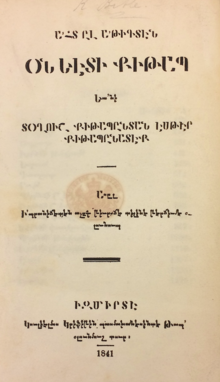
Back 아르메니아-튀르키예어 알파벳 Korean Армяно-турецкая письменность Russian Alfabeti armeno-turk Albanian Ermeni harfli Türkçe Turkish
This article relies largely or entirely on a single source. (May 2019) |
| Armeno-Turkish alphabet | |
|---|---|
 Front page of Old Testament written in Armeno-Turkish alphabet | |
| Script type | |
| Creator | Mesrop Mashtots |
| Languages | Ottoman Turkish language |
| Related scripts | |
Parent systems | Armenian script
|
Sister systems | Latin Coptic Georgian Cyrillic |
The Armeno-Turkish alphabet is a version of the Armenian script sometimes used to write Ottoman Turkish until 1928, when the Latin-based modern Turkish alphabet was introduced. The Armenian script was not just used by ethnic Armenians to write the Turkish language, but also by the non-Armenian Ottoman Turkish elite.
An American correspondent in Marash in 1864 called the alphabet "Armeno-Turkish", describing it as consisting of 31 Armenian letters and "infinitely superior" to the Arabic or Greek alphabets for rendering Turkish.[1]
This Armenian script was used alongside the Arabic script for official documents of the Ottoman Empire written in Ottoman Turkish. For instance, the first novel to be written in Turkish in the Ottoman Empire was Vartan Pasha's 1851 Akabi Hikâyesi, written in the Armenian script.